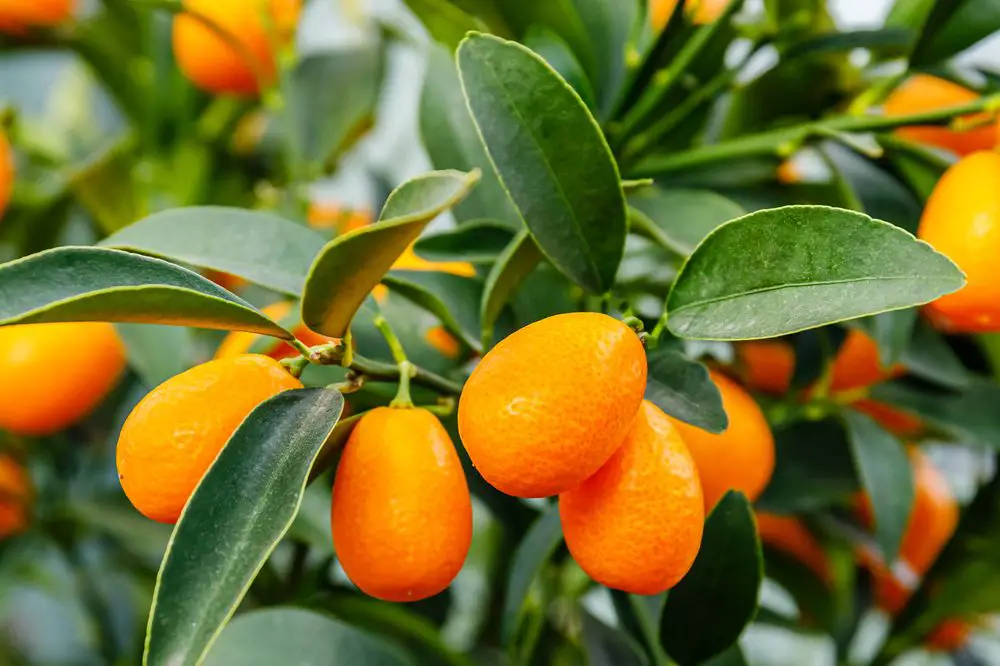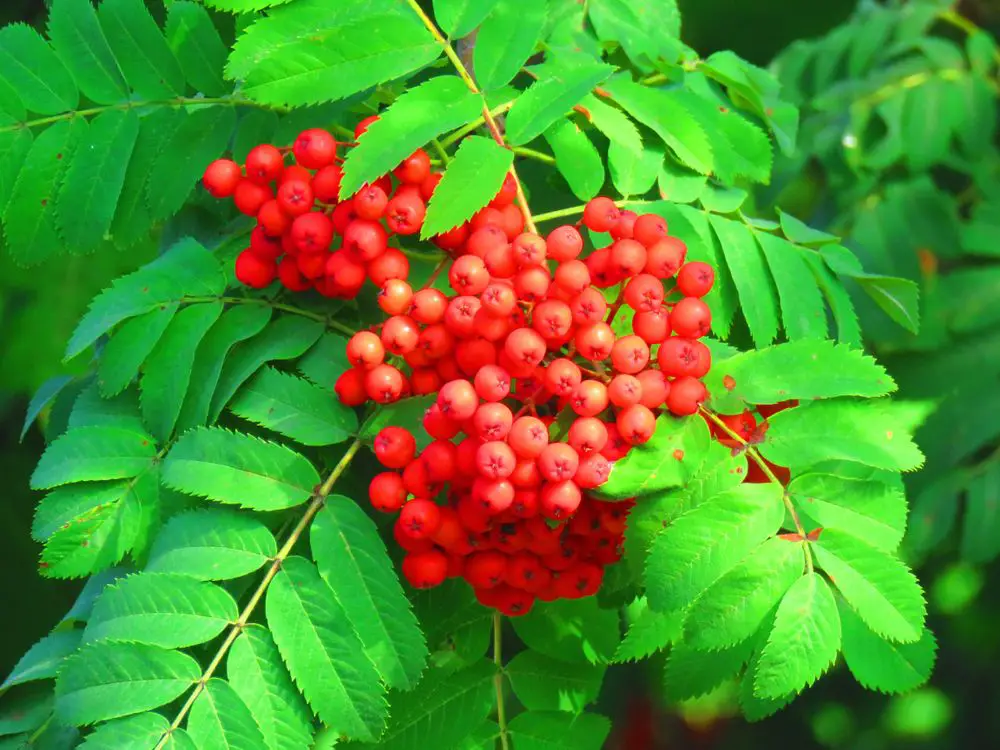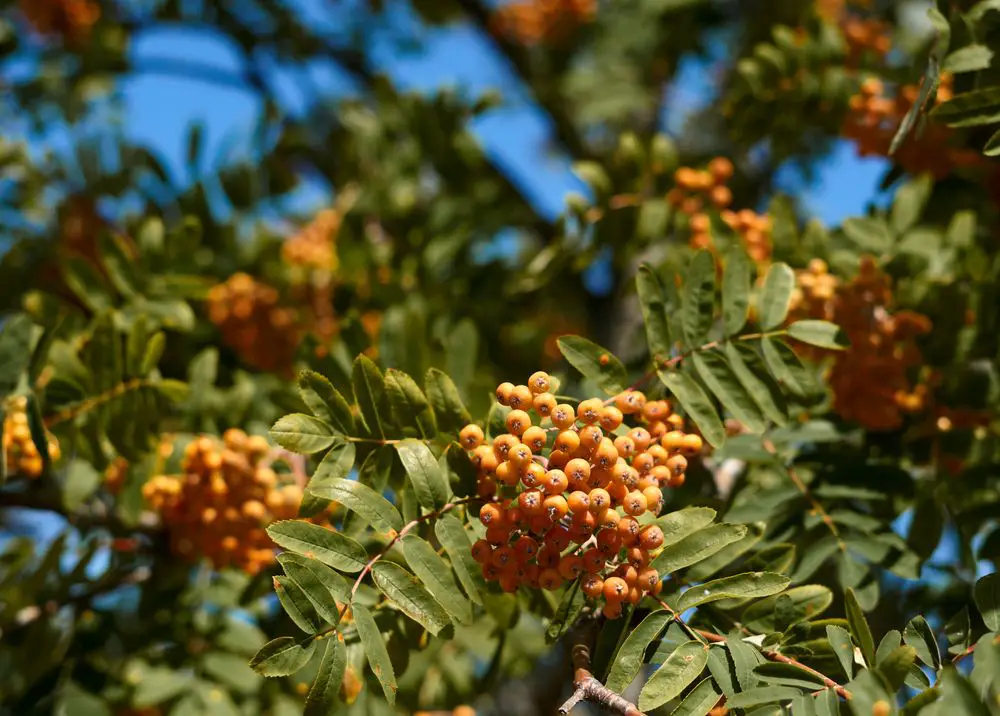Trees with orange berries offer more than just shade. The orange berries add color to your landscape – and birds are attracted to orange berries. Some of these fruits are edible by humans and wildlife, while others are poisonous.
What are the ways how to identify a tree with orange berries? Location of tree, size of berries, color and shape of leaves, and time of year orange berries appear. All the whys and wherefores are below.
How to Identify Trees with Orange Berries or Fruit
It is not common to find orange berries on trees because most of them grow on shrubs.
Proper identification of trees with orange berries is based on several factors:
Step 1. Location of the Tree. Sun or shade.
Step 2. Size of the orange berries. Orange berries are typically 1-inch long and grow in bunches.
Step 3. Color and shape of the leaves. The leaves are dark green in summer and turn yellow in fall.
Step 4. Time of the year orange berries appear. Orange berries typically appear in spring.
Trees with Orange Berries
1. Exotic Trees with Orange Berries
Kumquat (Fortunella) and Litchi are two exotic trees with orange berries.
Kumquat

The Kumquat tree grows outdoors in USDA zones 8-10. It has a round or vase-like canopy. It grows on evergreen trees and can be 8-15 feet tall.
This citrus tree grows 1-inch-long orange berries. The fruit can be eaten without being peeled because its rind is sweet. Its pulp is, however, sour.
At first glance, the kumquat orange berries look like small oranges. Kumquats, however, are a bit more oval and are not as sweet as oranges. Kumquat peels are edible, too.
Litchi
Litchi or Lychee is a tree that grows in USDA hardiness zones 9 – 11. Litchi or Lychee has small, white flowers that grow into orange berries in spring.
The litchi tree is an evergreen tree. It has a bright green compact crown-like foliage. Its leaves come with 2 to 4 pairs of leaflets that are 2-3 inches long.
The berries, when ripe, are covered by a reddish-orange casing. The white and sweet fruit can be found inside the fragile casing.
2. Ornamental Trees with Orange Berries
Pittosporum (Pittosporum undulatum)
The Pittosporum is an ornamental evergreen tree. It can grow to be 25 feet tall in USDA zone 8 – 11. The tree comes with bell-shaped clusters of flowers that become pea-size orange berries.
The orange berries typically split open when ripe and can be all over your driveway and lawn.
Hawthorn (Crataegus laevigata)
This ornamental tree also produces orange berries. It can grow to 25 feet tall. A mature hawthorn tree appears round and has thorny branches. It grows in USDA zones 4-8 areas.
3. Trees with Edible Orange Berries
Sour Cherry (Prunus cerasus)
Sour Cherry trees are also called the dwarf cherry tree or the tart cherry tree. It is a small deciduous tree different from the sweet cherry tree because of the quality of its fruits. The berries of the Sour Cherry are also tarter and more acidic.
Cherry trees have thin trunks with branches first growing low on the trunk and then ascending upwards. Its twiggy branches grow thickly together creating a nice canopy.
The tree has a dark grey bark covered by lenticels. It has oval-shaped and forest green leaves with pointed tips on both sides. The leaves turn yellow in autumn.
Cherry trees produce white or light pink clustered flowers with 5 petals. The flowers appear in early spring. Sour cherry trees are self-fruitful. It only takes one cherry tree to yield fruits without the help of pollinators.
The Sour Cherry tree produces cherry-like fruits that are sour, acidic, and rich in antioxidants.
Cherry trees need a few hours of chilling period (320F to 450F) to blossom and produce fruits. Cherry trees bear orange berries with a blushed yellow.
Crabapple (Malus sylvestris)
Crabapples are adaptable and trees. They are popular because they add beauty to a garden all season long. The Crabapple tree grows in USDA zones 4-8.
The Crabapple tree has white flowers in spring followed by orange berries called crabapples.
Mountain Ash ((Sorbus aucuparia)

This is also known as the Rowan tree. This is an ancient and beautiful tree with practical and visual qualities.
The Mountain Ash is a small to medium tree. It comes with grayish bark. Its deciduous leaves are dark green in summer and yellow in fall.
This tree can easily be identified with the enormous clusters of orange berries in the foliage during spring, summer, and fall. The bright orange color of the fruit tends to overpower the small dark green leaves of the tree.
When you inspect each orange berry, you will notice that the bottom of each one looks like the top of a tomato but in miniature!
The Mountain Ash attracts a wide range of birds to your yard. This can be beneficial because birds eat most of the orange berries leaving you with nothing to clean up.
The white flowers of the Mountain Ash tree and its orange berried bloom by June. The orange berries have a beautiful ornamental appeal. They can also be used in several recipes as well in jellies, jams, liqueur, and wine.
When eaten fresh, the orange berries from the Mountain Ash tree can be possibly unsafe. When you eat a large amount, you may have stomach pain and irritation, diarrhea, queasiness, vomiting, and other side effects.
Western Soapberry (Sapindus Drummondii)
This tree produces grape-like and single-seeded orange berries in fall that blacken in winter.
This tree is hardy in UDA zones 6-9. The tree is characterized by its gray bark that can grow to 20 to 50 feet tall and wide. It has pinnate leaves, consisting of 8 to 15 green leaflets, which turn yellow in the fall. It thrives in light shade or full sun.
4. Topiary Trees with Orange Berries
Topiary trees are tall and pruned into fancy or geometric shapes. Some topiaries with orange berries include:
Pyracantha (Pyracantha coccinea)
The Pyracantha or Orange Glow is better known as Firethorn.
This tree produces white blossoms in spring. The tree bears dark-orange berries in fall.
What are Orange Berries?
Orange berries are produced by shrubs and trees.
They are native to vine tickets and rainforests in tropical Australia, Bundaberg, and Asia. Orange berries are tasty and typically grow from small trees.
Trees with orange berries first grow tiny sweet-smelling white flowers followed by small orange berries that are as sweet as honey. The foliage of the trees is aromatic and glossy.
Orange berries belong to the citrus family. The small trees can be grown as part of a bush food garden. Trees with orange berries, when young, are host plants for swallow-tailed butterflies.
An orange berry, like almost all berries, is a fleshy fruit that grows from the ovary of one flower.
They attract birds and wildlife to your yard.
Further, they can be safe for humans and pets but be sure. Some are poisonous and can lead to mild and serious symptoms.
Orange berries make delicious jams and taste just like candied honey.
It is essential to know of ways how to identify a tree with orange berries to determine which berries to consume and which to avoid.
Are Orange Berries Poisonous?
Deciduous and evergreen trees yield brightly colored berries that attract many birds and other wildlife to gardens and landscapes.
Many of these berries are poisonous for humans and pets.
Toxic berries may be orange, red, white, yellow, purple, blue, or green. Eating these berries can cause serious respiratory and digestive damage.
To prevent accidental poisoning, it is crucial that you learn about the trees and plants that grow around your home, especially deciduous shrubs and trees, as well as evergreens.
Final Thoughts on Ways How to Identify a Tree with Orange Berries
We’ve presented you with a lot of information about how to identify trees with orange berries – we hope you’ll find it useful.
Obviously, we haven’t mentioned all the orange berry bearing plants such as the Berberis, the Hackberry, Junipers, or the Ilex (Holly); and there are still many others we’ll probably discuss another day.
Jenny Marie
Tribal Writer
N.B. Don’t confuse the orange berries with golden berries – which is another subject for another time. (On a personal note: Most of us love berries. It’s lovely to take a leisurely stroll in gardens, parks or woods and find wonderful looking berries.
On forays to find mushrooms, herbs and other interesting and useful plants, I’ve often seen people (both adults and children) picking up fallen berries and eating them without inspecting them first.
Sadly, if we don’t know what we’re putting into our mouths, we could poison ourselves. Please be careful and find out more about what fruits and berries you eat and, at least, wash them first. Be safe.)
Edit and Footnote By Patricia Godwin

